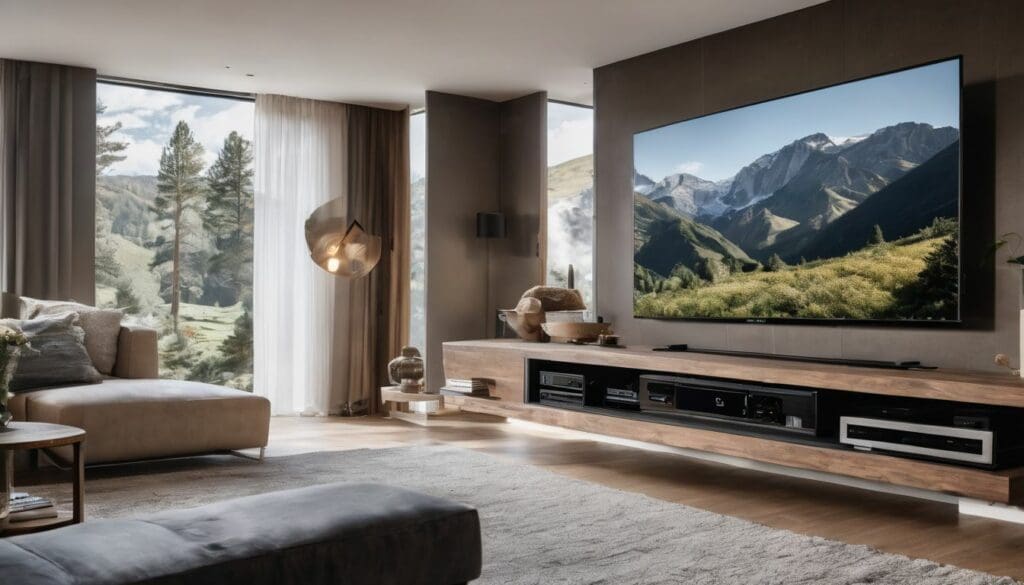We’ve all felt that familiar tug, haven’t we? Longing to get lost in our most-loved series, yet there’s a niggling concern about the carbon footprint it’s stamping on dear old Mother Earth.
It’s a conundrum many of us eco-warriors grapple with. And would you believe it—our regular home entertainment systems can be as hungry for energy as your kitchen fridge? That’s why we’ve put together this handy guide chock-full of smart tweaks for creating an environmentally friendlier viewing nook.
By making these small but mighty changes to your routine, you’ll be able to settle into your sofa sessions knowing they’re gentler on our planet. So grab a cuppa and let’s explore how you can indulge in those treasured down-times without the side serving of eco-guilt!
Key Takeaways
- Switching to LED lighting in your home theatre setup can significantly cut down on energy use and heat production, offering a more cost-effective and eco-friendly alternative to traditional bulbs.
- Investing in upgradeable hardware with Energy Star – rated audio and video equipment allows for the incorporation of the latest green technologies while reducing electricity bills and environmental impact over time.
- Opting for refurbished tech extends the lifespan of devices, decreases e-waste, promotes a circular economy, and provides access to quality entertainment systems at an affordable price point.
The Need for Sustainable Entertainment
Traditional home entertainment systems consume a significant amount of energy, contributing to carbon emissions and environmental degradation. It is crucial to reduce our energy consumption and invest in eco-friendly home entertainment systems for a more sustainable future.
Impact of traditional home entertainment systems
We often overlook the energy demands of traditional home entertainment systems, but they contribute significantly to household electricity use. Large-screen TVs, gaming consoles, and powerful sound systems can consume a lot of power even when not in use, especially if left on standby.
This constant drain adds up over time, increasing our carbon footprint and affecting the environment.
Our aim as eco-conscious individuals is to enjoy our favourite shows and games while minimising this impact. By switching off devices completely when they’re not needed and being mindful of the energy ratings of new purchases, we make strides towards more sustainable entertainment systems.
Every action counts towards reducing emissions and protecting natural resources for future generations.
Importance of reducing energy consumption
To create sustainable home entertainment, reducing energy consumption is vital. We can achieve this by embracing low-energy audiovisual solutions and eco-friendly projector options.
By using energy-efficient audio and video equipment and LED lighting, we reduce our carbon footprint. Incorporating efficient insulation and ventilation in our home theater setup also ensures that we maximise energy efficiency.
Furthermore, automated energy management systems play a key role in managing power usage effectively. These steps not only benefit the environment but also lead to cost savings over time through reduced electricity bills.
Eco-Friendly Features to Incorporate in Home Entertainment Systems
Incorporating LED lighting, energy-efficient audio and video equipment, efficient insulation and ventilation, and automated energy management systems can significantly reduce the environmental impact of home entertainment systems.
Making these eco-friendly features a priority in your setup will not only benefit the environment but also help you save on energy costs in the long run.
LED lighting
LED lighting is an energy-efficient choice for home entertainment systems, using less power and lasting longer than traditional bulbs. These lights not only save on electricity but also produce less heat, contributing to a cooler and more eco-friendly environment.
By incorporating LED lighting into your home theatre setup, you can enjoy high-quality illumination while reducing energy consumption significantly. LED technology offers versatile options that align with sustainable living and ethical choices in audiovisual setups, making it an ideal addition for environmentally conscious individuals striving to support conservation efforts.
Energy-efficient audio and video equipment
When designing an eco-friendly home entertainment system, prioritising energy-efficient audio and video equipment is essential. By opting for low-energy consumption speakers, amplifiers, receivers, and televisions, environmentally conscious individuals can significantly reduce their carbon footprint.
Choosing AV technology with the Energy Star label or other eco-friendly certifications ensures that the equipment meets high standards of energy efficiency while still delivering top-notch performance.
Integrating energy-efficient audiovisual systems not only reduces environmental impact but also leads to long-term cost savings on utility bills. These sustainable options offer a compelling combination of cutting-edge technology and responsible resource management, aligning with the green living principles embraced by conservation-minded individuals who seek out environmentally friendly AV technology for their homes.
Efficient insulation and ventilation
For an eco-friendly home entertainment system, it’s crucial to incorporate efficient insulation and ventilation. Proper insulation helps in maintaining a consistent indoor temperature, reducing the need for excessive heating or cooling.
Ventilation ensures fresh air circulation, creating a healthy environment while minimising energy use. These features are vital for energy-efficient home theaters and sustainable audiovisual setups, contributing to lower energy consumption and reduced environmental impact.
When designing an eco-conscious home entertainment space, prioritising efficient insulation and ventilation is essential. This not only enhances comfort but also aligns with sustainable living practices – keywords: low-impact entertainment systems; environmentally friendly audiovisual setups.
Automated energy management systems
Automated energy management systems efficiently regulate power usage, adjusting settings based on need. These systems maximise energy efficiency by automatically controlling lighting, temperature, and electronics.
With the use of sensors and timers, they optimise energy consumption without sacrificing comfort or convenience.
Implementing an automated system allows for a seamless reduction in energy usage while maintaining an eco-friendly home entertainment setup. Such technology aligns with sustainable living goals by minimising unnecessary power wastage and reducing environmental impact from excessive electricity consumption.
Maximising Energy Efficiency in Home Entertainment Systems
We will explore ways to maximise energy efficiency in home entertainment systems through upgradeable hardware, sustainable materials, ethical alternatives, and buying refurbished tech.
Find out more about these eco-friendly solutions by reading the full blog post!
Upgradeable hardware
Upgrading hardware allows for the integration of newer, more energy-efficient components into your home entertainment system. This can ensure that your equipment stays up to date with the latest eco-friendly technologies.
Upgrading also provides an opportunity to replace any outdated parts with sustainable materials, contributing to a greener and more ethical home entertainment setup.
Investing in upgradeable hardware not only enhances performance but also supports a sustainable approach to home entertainment technology. By making conscious choices when upgrading, you can align your system with green living principles and reduce energy consumption in your household.
Sustainable materials
When considering sustainable materials for home entertainment systems, it’s crucial to opt for eco-friendly options that have minimal environmental impact. Utilising materials such as bamboo, reclaimed wood, and recycled plastics can significantly reduce the carbon footprint of your entertainment setup.
These materials not only contribute to conservation efforts but also add a touch of natural elegance to your living space. By choosing sustainable materials for your home entertainment system, you can enjoy guilt-free leisure time while aligning with environmentally responsible practices.
Incorporating these eco-conscious choices promotes a greener lifestyle and showcases your support for sustainable solutions in the audiovisual industry. It’s vital to consider the long-term benefits of using sustainable materials not just for their positive environmental impact but also for creating healthier indoor environments and supporting ethical production processes within the home entertainment sector.
Ethical alternatives
To further promote sustainability, consider ethical alternatives in your home entertainment system. You can opt for products from companies that uphold ethical manufacturing practices and prioritise environmental responsibility.
Seek out brands that use recycled or sustainable materials in their products, reducing the demand for new resources. Additionally, choose energy-efficient audio and video equipment made by manufacturers committed to reducing their carbon footprint.
By supporting ethical alternatives, you contribute to a more environmentally friendly home entertainment setup while encouraging responsible business practices within the industry.
Incorporating ethical alternatives into your home entertainment system not only benefits the environment but also supports businesses striving for sustainability. Look for eco-friendly projector options and low-impact audiovisual solutions to minimise your ecological footprint without compromising on quality or performance.
Buying refurbished tech
When looking for eco-friendly home entertainment solutions, buying refurbished tech can be an excellent choice. Refurbished electronics such as audiovisual equipment and home theater systems offer a sustainable alternative to purchasing new products.
By opting for refurbished tech, you extend the lifespan of electronic devices, reducing e-waste and promoting environmental conservation. Additionally, choosing refurbished tech enables you to access high-quality entertainment technology at a more affordable price point while contributing to the circular economy by giving used electronics a second chance.
Considering the benefits of reduced environmental impact and cost-effectiveness, incorporating refurbished tech into your home entertainment system aligns with eco-conscious values.
Creating an Eco-Friendly Manufacturing Supply Chain for Home Entertainment Systems
Assessing current practices in manufacturing and choosing eco-friendly materials are crucial steps in creating a sustainable supply chain for home entertainment systems. Optimising production processes, managing logistics, extending product life cycles, and implementing product take-back and recycling programmes are also important considerations for reducing environmental impact.
Assessing current practices
To ensure that our home entertainment systems are environmentally responsible and sustainable, we need to closely evaluate our current practices. This assessment involves:
- Analysing the energy usage of existing equipment to identify areas for improvement.
- Evaluating the use of sustainable materials in the production of entertainment systems.
- Reviewing the disposal and recycling processes for outdated technology.
- Considering the environmental impact of transportation and distribution logistics.
- Auditing the overall manufacturing process to identify opportunities for reducing waste and energy consumption.
Choosing eco-friendly materials
Choosing eco-friendly materials is essential in creating sustainable home entertainment systems. Consider the following eco-conscious options for your home entertainment setup:
- Recycled or reclaimed wood for furniture and speaker cabinets to reduce demand for new timber and minimise deforestation.
- Organic fabrics and textiles for soundproofing materials, upholstery, and curtains to avoid using synthetic materials that release harmful chemicals.
- Bamboo flooring or sustainable cork flooring as eco-friendly alternatives to traditional hardwood floors, which often involve unsustainable logging practices.
- Low – VOC (volatile organic compounds) paint for walls and ceilings to minimise indoor air pollution and support healthy indoor air quality.
- Eco – friendly acoustic panels made from recycled materials for noise control and sound diffusion purposes.
Optimising production processes
To ensure an environmentally conscious approach to the manufacturing of home entertainment systems, optimising production processes is imperative. Here are some ways that can be done:
- Streamlining manufacturing operations to reduce waste and energy consumption.
- Implementing eco – friendly manufacturing techniques such as 3D printing and laser cutting.
- Utilising automation to minimise manual labour and increase efficiency.
- Investing in renewable energy sources for the manufacturing facility.
- Collaborating with suppliers who adhere to sustainable practices for sourcing raw materials.
- Conducting regular assessments to identify opportunities for improvement in the production process.
Managing logistics and distribution
We streamline the supply chain by selecting eco-friendly materials and optimising production processes. We extend product life cycles, implement product take-back, and recycling initiatives to reduce waste.
Our environmentally sustainable approach ensures that every step of logistics and distribution aligns with our commitment to conservation.
Ensuring efficient transportation methods reduces carbon emissions significantly. Our dedication to environmental responsibility extends from manufacturing to delivery, minimising our overall impact on the planet.
Extending product life cycle
To extend the product life cycle of eco-friendly home entertainment systems, we focus on durability and repairability. By using high-quality, long-lasting materials in manufacturing, products contribute to reducing waste and conserving resources.
Designing products with modular components allows for easy repairs and upgrades, ensuring that the system stays relevant for a longer period. Furthermore, implementing take-back programmes encourages customers to return old equipment for proper recycling or refurbishment, reducing environmental impact and promoting a circular economy in the home entertainment industry.
Maximising energy efficiency through thoughtful design choices is essential while creating sustainable AV solutions. At every stage of production – from sourcing raw materials to distribution – incorporating eco-friendly practices reduces the environmental footprint of home entertainment systems.
Implementing product take-back and recycling
- Extending product life cycle through responsible disposal methods
- Offering take – back programmes for old electronic equipment
- Collaborating with recycling facilities to ensure proper disposal of materials
- Encouraging customers to return outdated products for recycling
- Providing incentives for returning used electronics for recycling
- Tracking and reporting on the amount of materials recycled from returned products
- Partnering with third-party organisations to manage product take-back and recycling initiatives
- Continuously improving and expanding the recycling infrastructure
- Educating consumers about the importance of responsible disposal practices
Conclusion
In conclusion, eco-friendly home entertainment systems offer sustainable options for audiovisual technology. Consumers can benefit from energy-efficient equipment and materials, contributing to a greener lifestyle.
By choosing eco-conscious alternatives and optimising energy management, individuals and families can enjoy entertainment while minimising their environmental impact. It’s time to embrace eco-friendly sound design and low-impact entertainment systems for a more sustainable future.
FAQs
1. What is an eco-friendly home entertainment system?
An eco-friendly home entertainment system is a setup that uses energy-efficient audiovisual systems and sustainable technology to reduce environmental impact.
2. How can I make my home theater more eco-conscious?
You can choose low-energy audiovisual solutions, invest in eco-friendly sound design, and use environmentally friendly projectors for your green home theater setup.
3. Are there specific features to look for in energy-efficient entertainment systems?
Yes, look for equipment with low power consumption, ethical sound design principles, and ecoconscious projector options that offer high performance with less energy use.
4. Can an eco-friendly projector deliver the same quality as regular projectors?
Ecofriendly projector technology has advanced so that they now provide excellent image quality while being more energy-efficient compared to traditional models.
5. Is it possible to have a complete green living room technology setup?
Absolutely! You can integrate green entertainment technology throughout your living room by selecting Earthfriendly home theater equipment and ecoresponsible home audiovisual setups.





